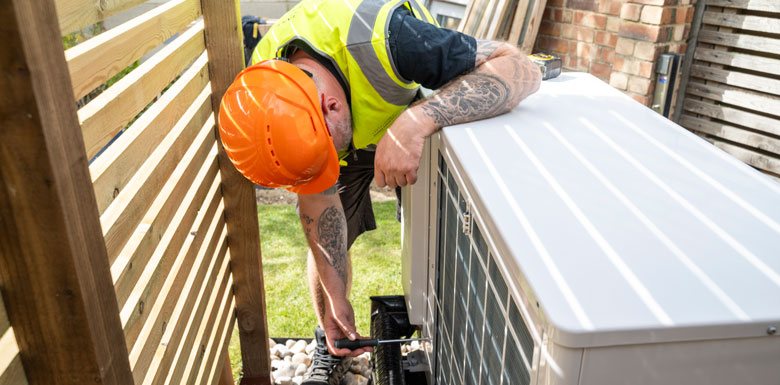How to sell green heating and insulation
 In this article
In this article
Households switching to green heating is an essential part of the government’s strategy to achieve its aim of reaching net zero by 2050. Almost a fifth of the UK’s carbon emissions are currently from home heating.
‘Green’ heating products, such as heat pumps, biomass boilers and solar panels, have been growing in popularity and demand is expected to increase. It's estimated that around 25 million UK households still use fossil fuels – mainly for heating – so the number of potential customers if you work in the sector is huge.
The increase in demand has been boosted by the government introducing more grants and funding schemes to encourage consumers to make the switch. The latest government figures show that applications for heat pump grants through the Boiler Upgrade Scheme (BUS) in England and Wales grew by 75% in February 2024 compared to the previous February.
The BUS launched in May 2022 but since October 2023 homeowners have been able to get a grant of £7,500 towards the installation of a heat pump. It was originally £5,000 for air source heat pumps and £6,000 for ground source heat pumps.
Misleading business practices
To ensure consumers can have confidence that they are getting a fair deal, the Competition & Markets Authority (CMA) – a government department that tackles unfair practices that can harm consumers – carried out a review of the sector. It looked at consumers’ experiences of buying these products, the practices of the businesses selling them and the effectiveness of the standards bodies that exist in this area.
The CMA found evidence of business practices that could mislead consumers, in particular:
- potentially misleading headline price information, including how businesses talk about access to government grants;
- potentially misleading claims about businesses’ products and services in their marketing, including on their websites.
As a result, the CMA has issued guidance to businesses selling heating and insulation products to help them comply with consumer protection law. This will allow consumers to be well informed and make the best buying decisions.
How to present headline price information
The headline price is a major factor in whether someone chooses to buy a product or not, so it’s important that you present it fairly.
The price you give to consumers must be:
- accurate – it should give a realistic idea of how much someone is likely to pay for the products you’re selling
- comprehensive – it should include all the unavoidable costs people will have to cover, such as the additional products they’ll need alongside a heat pump
- honest – don’t mislead people about how much they will end up paying, such as by giving an unrealistically low price
- clear – any information that explains or qualifies the price, such as the size of property your quote is based on, should be displayed as close to the headline price as possible
- careful in how it presents information about government funding – be wary about deducting the value of a government grant from the price if most people won’t be eligible for it, for example. If you deduct a grant because most people will get it, you should make this clear
- open about bundles – you must be clear if your price is based on offering products as a bundle and not mislead people about the nature of the offer. For example, you could also show how much you would charge if they bought the products from you separately.
How to make product claims
The claims you make about your products is another important factor when people are deciding whether to buy. When it comes to green heating and insulation, they may be particularly reliant on your claims as these products are unfamiliar to many consumers.
The CMA guidance sets out five principles you should follow to give you the best chance of staying on the right side of the law:
Have evidence
You should have documentary evidence to back up any claim you make. The evidence should be up to date and specific to any claim you’re making to ensure that the claim is accurate, truthful and not misleading. For example, don’t use performance data for a product when it’s used in a commercial setting if you’re selling it for domestic use.
Explain everything the consumer needs to know
If you leave out important information it can make a claim misleading, so make sure it’s comprehensive. Qualifying information, such as assumptions used to make the claim or the conditions required for it to be true, should be displayed as near as possible to the claim itself. Explain any calculations and state the evidence sources you’ve used.
Also consider the marketing channel you’re using. Social media might not be the best place to make a claim, for example, as there may not be enough space to include all the necessary information.
Be careful when using ‘up to’
A claim that uses ‘up to’ a certain price or ‘up to’ a particular level of performance can be misleading if it won’t be achieved by a significant proportion of people. You should have credible evidence that this is the case. You’re more likely to comply with the law if you quote the minimum outcome instead.
Be realistic and representative
Claims should be based on what the conditions would be for most consumers, not on very specific circumstances or on situations unlikely to occur in the real world. For example, a claim based on the performance of a product in lab conditions may not be a fair representation of how it would perform in someone’s home.
Any comparisons should be made on a like-for-like basis. Don’t exaggerate the benefits of your products versus others. If you’re mentioning a competitor’s product, you should provide enough information for the consumer to be able to check the comparison themselves.
Choose your words carefully
Be wary of using words that overstate the benefits or the level of likelihood that a particular outcome will be achieved. Use language that’s simple, clear and specific without using jargon. Explain any terms consumers might not understand. Your messages should be consistent across all your marketing, whatever channels you’re using.
It’s also important to consider your company name and logo as well as the images and colours you use to ensure they don’t mislead people or exaggerate your claims.
For more information on how to market green heating and insulation products, visit Gov.uk.




